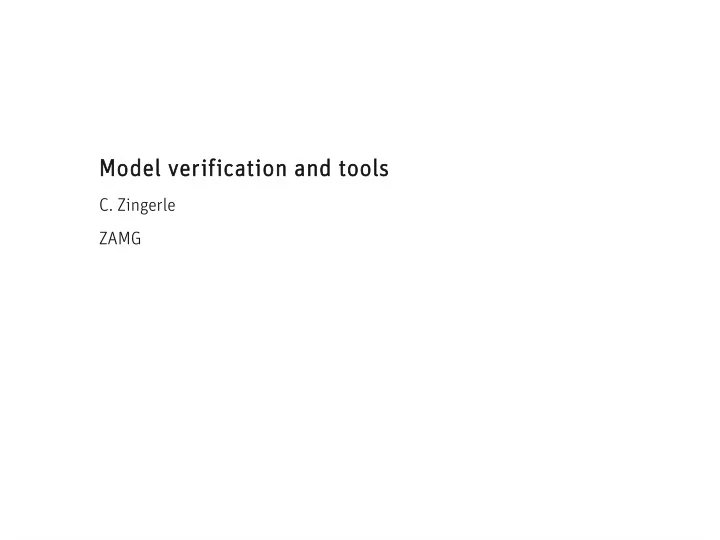

Model verification and tools C. Zingerle ZAMG
Why verify? The three most important reasons to verify forecasts are: • to monitor forecast quality - how accurate are the forecasts and are they improving over time? • to improve forecast quality - the first step toward getting better is discovering what you're doing wrong. • to compare the quality of different forecast systems - to what extent does one forecast system give better forecasts than another, and in what ways is that system better?
What is the truth? • The truth data comes from observational data: SYNOPs, raingauges, satellite observations, radar, analysis systems. • Most of the time we ignore errors in observations / analysis, because the error of the observation / analysis is much smaller than the one expected by the forecasting system.
What makes a forecast good? • Consistency - the degree to which the forecast corresponds to the forecaster's best judgement about the situation, based upon his/her knowledge base • Quality - the degree to which the forecast corresponds to what actually happened • Value - the degree to which the forecast helps a decision maker to realize some incremental economic and/or other benefit In model verification we are mostly interested in quality measures, somtimes in value. Most emphasized aspects are accuracy (agreement between forecast and observation) and skill (accuracy of a forecast over some reference).
Different specificity of forecast asks for a number of different basic verification methods • Dichotomous (yes/no): e.g. occurrence of fog visual, dichotomous, probabilistic, spatial, ensemble • Multi-category: e.g. cold, normal, or warm conditions visual, multi-categorical, probabilistic, spatial, ensemble • Continuous: e.g. maximum temperature visual, continuous, probabilistic, spatial, ensemble • Object- or event-oriented: e.g. cyclone motion and intensity visual, dichotomous, multi-categoriy, coninuous, probabilistic, spatial
Categorical or mulit-cateogrical forecasts Contingency table Accuracy, frequency bias, POD, FAR, POFD, SR, TS, ETS, OR, HK, HSS ...
Conintuous forecasts Scatterplot, boxplot ME, BIAS, MAE, RMSE, MSE, LEPS, Skill score, correlation coefficient, anomally correlation,
Probability forecasts Reliability diagram, ROC diagram, Brier score Brier skill score Ranked probability score Ranked probability skill score Relative value
Spatial forecasts FC FC OB OB OB FC FC BIAS << BIAS >> RMSE < RMSE >> FAR = around 0 FAR = 1 POD = around 1 POD = 0 … …
Spatial forecasts FC FC OB OB OB FC FC BIAS << BIAS >> RMSE < RMSE >> FAR = around 0 FAR = 1 POD = around 1 POD = 0 … …
Spatial forecasts Double Penalty Problem: In a grid-point by grid-point verification coarse scale models scores often better than high resolution models: Even in close fails of high resolution forecast we get worse: BIAS goes up POD goes down FAR rise RMSE rise … Penalized once for missing an observation and a second time for giving a false alarm
Spatial forecasts SAL CRA Fuzzy FSS Intensity scale Morphing …
Tools for model verification in Aladin Aladin performance monitoring tool (Ljubljana) Montoring of Aladin implementations in the member NMS using standard verification methods (SYNOP and TEMP, continuous and mulit-categorical variables) • Centralized system at Ljubljana, each member is sending his model data to the database HARP Hirlam – Aladin R-package: Adaption and development for probabilistic and spatial verification • Local system: Toolbox to be adapted locally at each NMS
Aladin performance monitoring tool
Aladin performance monitoring tool
HARP Hirlam – Aladin R-package Model Util for spatial fields • Read from SQLite data files or from spatial data R fields util (local) verif. SQLite Calculate scores • tables scripts • Write to SQlite results (just for files station Observation util data) data • Read from SQLite results files R SQLite • Plot Plot verif. tables graphics util (EPS scripts and spatial)
HARP Hirlam: EPS verification
HARP Hirlam: EPS verification
HARP Hirlam: spatial verification
APMT: • Point verification • Centralized • Monthly report (pdf) for each country • Beeing currently re-fitted HARP: • EPS & spatial verification • Locally • Operational visualization locally (visualization utility) • Still under development
Recommend
More recommend